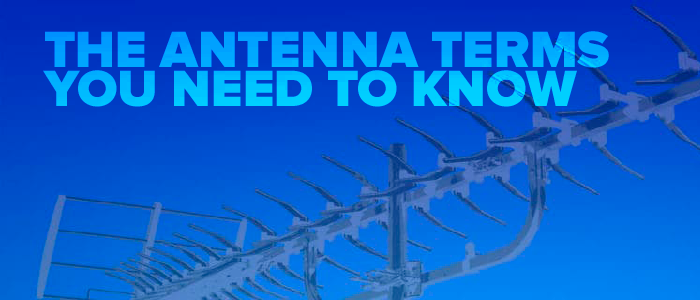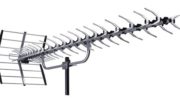You might have heard the term “log-periodic” when it comes to antennas. I’ve used the term before on this blog.
A log-periodic antenna, also referred to as a log periodic dipole array, is the most complex kind of antenna. It’s actually multiple antennas all together.

In a log-periodic antenna, each one of the elements is actually wired up. Each one acts as its own diple antenna, receiving a specific range of frequencies. Because of the placement of each element, each element also acts as a director, increasing the efficiency of the antenna element behind it.
Is it a log-periodic, or a yagi?
A lot of times, the generic term “yagi” is used for any large antenna that sort of looks like the one in the picture. Technically they are two different things. The yagi has one driven element and the rest of the antenna focuses the signal on that element. The log-periodic has more than one driven element.
However, in the world of TV antennas, it’s rare that you see an antenna that is a pure log-periodic. In the photo above, the section to the right, past the two oddly angled parts, is a log-periodic antenna. However, the section to the left is actually a yagi antenna tuned for UHF freqencies. So it’s fair to call it a log-periodic or a yagi, because it’s actually both.
Why do we call it a “log-periodic?”
The log-periodic antenna was invented in 1958. Prior attempts to create antenna arrays created a lot of interference, but the LPDA design used math to space the elements out so there wasn’t any problem.
This design arranges the elements in relationship to the logarithm of the actual frequency received by the individual elements, and that accounts for the name. It’s also worth noting that the an engineer invented the log-periodic antenna not a marketer. This explains why its name isn’t perhaps as catchy as you’d think it could be.
Which is better, a log-periodic or a yagi?
Smart readers may point out that in theory, a yagi antenna should outperform a log-periodic antenna. In a yagi antenna, one single element receives all the signal. The rest of the antenna focuses that signal. However, that element has to be able to work with several frequencies at once. If you have a very large range of frequencies, such as you have with VHF television, individual elements are the right choice even though each individual element will not have as much gain as s yagi design would.
Shop for antennas at Solid Signal
You’ll find the best selection of antennas by shopping the great selection at Solid Signal. There are antennas for every situation, not just yagis and log-periodic antennas, but also simple dipoles of many different types. If you don’t know which antenna you need, check out our free antenna recommendation service. A professional in our Michigan headquarters reviews each antenna request. Not only that, a technician creates each recommendation to your specific needs. The result is better than any app is capable of giving you, and you can actually contact the technician who did your recommendation and ask them questions. Try it out today!





